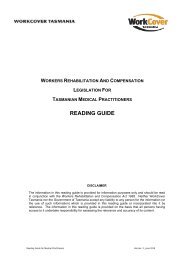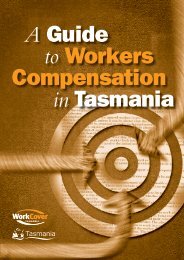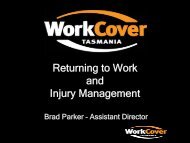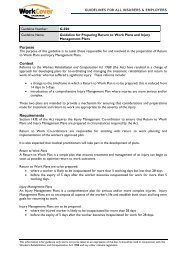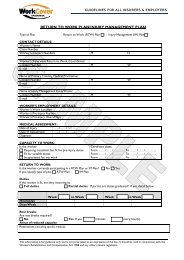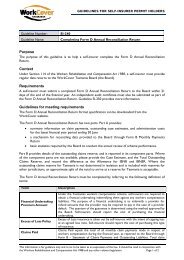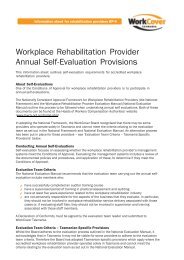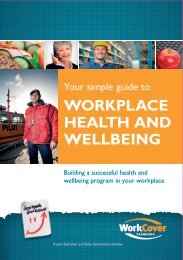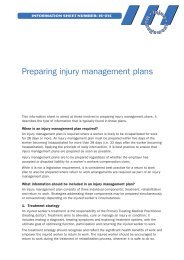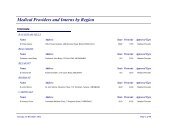Guidelines for the assessment of permanent impairment Version 3
Guidelines for the assessment of permanent impairment Version 3
Guidelines for the assessment of permanent impairment Version 3
Create successful ePaper yourself
Turn your PDF publications into a flip-book with our unique Google optimized e-Paper software.
Chapter 3Lower Extremity ImpairmentIntroduction3.1 The lower extremity is discussed in section 3.2 <strong>of</strong> Chapter 3 in <strong>the</strong> AMA 4 Guides (pp 75 - 93).This section is complex and provides a number <strong>of</strong> alternative methods <strong>of</strong> assessing <strong>permanent</strong><strong>impairment</strong> involving <strong>the</strong> lower extremity. An organised approach is essential and findingsshould be carefully documented on a worksheet.The Approach to Assessment <strong>of</strong> <strong>the</strong> Lower Extremity3.2 There are several different <strong>for</strong>ms <strong>of</strong> evaluation that can be used as indicated in sections 3.2a to3.2m <strong>of</strong> <strong>the</strong> AMA 4 Guides (pp 75 - 89). Table 3.1 in <strong>the</strong>se <strong>Guidelines</strong> indicates which evaluationmethods can and cannot be combined <strong>for</strong> <strong>the</strong> <strong>assessment</strong> <strong>of</strong> each injury. This table can only be usedto assess one combination at a time. It may be possible to per<strong>for</strong>m several different evaluations aslong as <strong>the</strong>y are reproducible and meet <strong>the</strong> conditions specified below and in <strong>the</strong> AMA 4 Guides.The most specific method, or combination <strong>of</strong> methods, <strong>of</strong> <strong>impairment</strong> <strong>assessment</strong> should beused. When more than one equally specific method or combination <strong>of</strong> methods <strong>of</strong> rating <strong>the</strong> same<strong>impairment</strong> is available, <strong>the</strong> method providing <strong>the</strong> highest rating should be chosen. Table 3.2 canbe used to assist <strong>the</strong> process <strong>of</strong> selecting <strong>the</strong> most appropriate method(s) <strong>of</strong> rating lower extremity<strong>impairment</strong>.3.3 Where more than one <strong>impairment</strong> parameter <strong>of</strong> lower extremity <strong>impairment</strong> exists <strong>for</strong> a single lowerextremity <strong>impairment</strong> <strong>the</strong> permissible combination table (Table 3.1) must be applied as describedabove.3.4 Where more than one extremity <strong>impairment</strong> arises from a work-related injury each <strong>impairment</strong> isassessed and combined to give <strong>the</strong> total lower extremity percentage <strong>impairment</strong>, <strong>the</strong>n this value isconverted to a % person <strong>impairment</strong>.3.5 If <strong>the</strong> contralateral uninjured joint has a less than average mobility, <strong>the</strong> <strong>impairment</strong> value(s)corresponding with <strong>the</strong> uninjured joint can serve as a baseline and are subtracted from <strong>the</strong>calculated <strong>impairment</strong> <strong>for</strong> <strong>the</strong> injured joint, only if <strong>the</strong>re is a reasonable expectation <strong>the</strong> injuredjoint would have had similar findings to <strong>the</strong> uninjured joint be<strong>for</strong>e injury. The rationale <strong>for</strong> thisdecision should be explained in <strong>the</strong> <strong>impairment</strong> <strong>assessment</strong> report.3.6 The assessed <strong>impairment</strong> <strong>of</strong> a part or region can never exceed <strong>the</strong> <strong>impairment</strong> due to amputation <strong>of</strong>that part or region. For a lower limb, <strong>the</strong>re<strong>for</strong>e, <strong>the</strong> maximum evaluation is 40% whole person<strong>impairment</strong>.WCT <strong>Guidelines</strong> 1 October 2011 13



